Engage NY Eureka Math 5th Grade Module 3 Lesson 4 Answer Key
Eureka Math Grade 5 Module 3 Lesson 4 Problem Set Answer Key
Question 1.
For the following problems, draw a picture using the rectangular fraction model and write the answer. When possible, write your answer as a mixed number.
a. \(\frac{2}{3}\) + \(\frac{1}{2}\) =
b. \(\frac{3}{4}\) + \(\frac{2}{3}\) =
c. \(\frac{1}{2}\) + \(\frac{3}{5}\) =
d. \(\frac{5}{7}\) + \(\frac{1}{2}\) =
e. \(\frac{3}{4}\) + \(\frac{5}{6}\) =
f. \(\frac{2}{3}\) + \(\frac{3}{7}\) =
Answer:
a. \(\frac{2}{3}\) + \(\frac{1}{2}\) = \(\frac{4}{6}\) + \(\frac{3}{6}\) = \(\frac{7}{6}\) = 1\(\frac{1}{6}\)
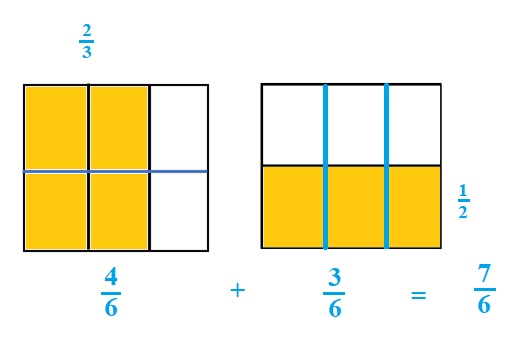
Explanation :
Divide the first rectangle into 3 parts using vertical lines as first fraction is \(\frac{2}{3}\) and each vertical section represents \(\frac{1}{3}\) and 2 parts are shaded.
Divide the Second rectangle into 2 parts using horizontal lines as Second fraction is \(\frac{1}{2}\) and each horizontal fraction represent \(\frac{1}{2}\) and 1 part is shaded.
As 2 and 3 have 6 lcm now divide both the rectangles into 6 parts .
First rectangle divided into 6 parts by drawing 1 horizontal lines and second rectangle into 6 parts by drawing 2 vertical line
Write fraction of shaded parts and add them .
b. \(\frac{3}{4}\) + \(\frac{2}{3}\) = \(\frac{9}{12}\) + \(\frac{8}{12}\) = \(\frac{17}{12}\) = 1\(\frac{5}{12}\)
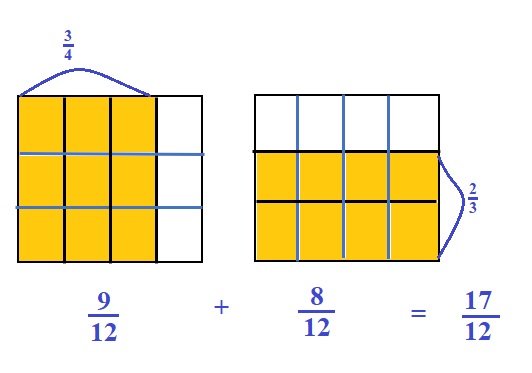
Explanation :
Divide the first rectangle into 4 parts using vertical lines as first fraction is \(\frac{3}{4}\) and each vertical section represents \(\frac{1}{4}\) and 3 parts are shaded.
Divide the Second rectangle into 3 parts using horizontal lines as Second fraction is \(\frac{2}{3}\) and each horizontal fraction represent \(\frac{1}{3}\) and 2 parts are shaded.
As 4 and 3 have 12 lcm now divide both the rectangles into 12 parts .
First rectangle divided into 12 parts by drawing 2 horizontal lines and second rectangle into 12 parts by drawing 3 vertical line
Write fraction of shaded parts and add them .
c. \(\frac{1}{2}\) + \(\frac{3}{5}\) = \(\frac{5}{10}\) + \(\frac{6}{10}\) = \(\frac{11}{10}\) = 1\(\frac{1}{10}\)
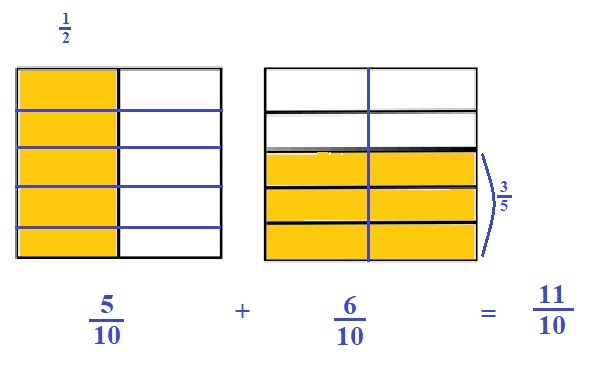
Explanation :
Divide the first rectangle into 2 parts using vertical lines as first fraction is \(\frac{1}{2}\) and each vertical section represents \(\frac{1}{2}\) and 1 part is shaded.
Divide the Second rectangle into 5 parts using horizontal lines as Second fraction is \(\frac{3}{5}\) and each horizontal fraction represent \(\frac{1}{5}\) and 3 parts are shaded.
As 2 and 5 have 10 lcm now divide both the rectangles into 10 parts .
First rectangle divided into 10 parts by drawing 1 horizontal line and second rectangle into 10 parts by drawing 1 vertical line
Write fraction of shaded parts and add them .
d. \(\frac{5}{7}\) + \(\frac{1}{2}\) = \(\frac{10}{14}\) + \(\frac{7}{14}\) = \(\frac{17}{14}\) = 1\(\frac{3}{14}\)
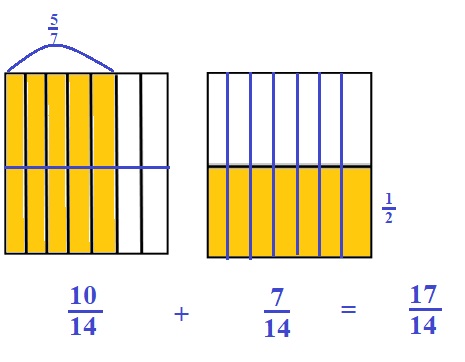
Explanation :
Divide the first rectangle into 7 parts using vertical lines as first fraction is \(\frac{5}{7}\) and each vertical section represents \(\frac{1}{7}\) and 5 parts are shaded.
Divide the Second rectangle into 2 parts using horizontal line as Second fraction is \(\frac{1}{2}\) and each horizontal fraction represent \(\frac{1}{2}\) and 1 part is shaded.
As 7 and 2 have 14 lcm now divide both the rectangles into 14 parts .
First rectangle divided into 14 parts by drawing 1 horizontal lines and second rectangle into 14 parts by drawing 7 vertical lines
Write fraction of shaded parts and add them .
e. \(\frac{3}{4}\) + \(\frac{5}{6}\) = \(\frac{9}{12}\) + \(\frac{10}{12}\) = \(\frac{19}{12}\) = 1\(\frac{7}{12}\)
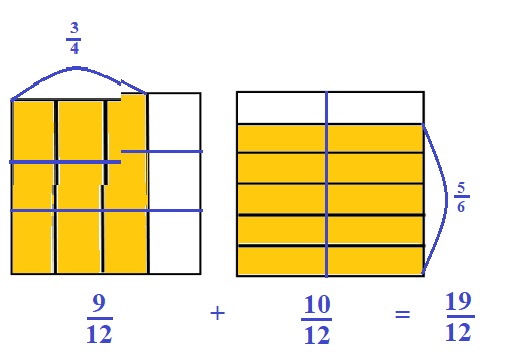
Explanation :
Divide the first rectangle into 4 parts using vertical lines as first fraction is \(\frac{3}{4}\) and each vertical section represents \(\frac{1}{4}\) and 3 parts are shaded.
Divide the Second rectangle into 6 parts using horizontal lines as Second fraction is \(\frac{5}{6}\) and each horizontal fraction represent \(\frac{1}{6}\) and 5 parts are shaded.
As 4 and 6 have 12 lcm now divide both the rectangles into 12 parts .
First rectangle divided into 12 parts by drawing 3 horizontal lines and second rectangle into 12 parts by drawing 1 vertical line
Write fraction of shaded parts and add them .
f. \(\frac{2}{3}\) + \(\frac{3}{7}\) = \(\frac{14}{21}\) + \(\frac{9}{21}\) = \(\frac{23}{21}\) = 1\(\frac{2}{21}\).

Explanation :
Divide the first rectangle into 3 parts using vertical lines as first fraction is \(\frac{2}{3}\) and each vertical section represents \(\frac{1}{3}\) and 2 parts are shaded.
Divide the Second rectangle into 7 parts using horizontal lines as Second fraction is \(\frac{3}{7}\) and each horizontal fraction represent \(\frac{1}{7}\) and 3 parts are shaded.
As 7 and 3 have 21 lcm now divide both the rectangles into 21 parts .
First rectangle divided into 21 parts by drawing 2 horizontal lines and second rectangle into 21 parts by drawing 2 vertical line
Write fraction of shaded parts and add them .
Solve the following problems. Draw a picture, and write the number sentence that proves the answer. Simplify your answer, if possible.
Question 2.
Penny used \(\frac{2}{5}\) lb of flour to bake a vanilla cake. She used another \(\frac{3}{4}\) lb of flour to bake a chocolate cake. How much flour did she use altogether?
Answer:
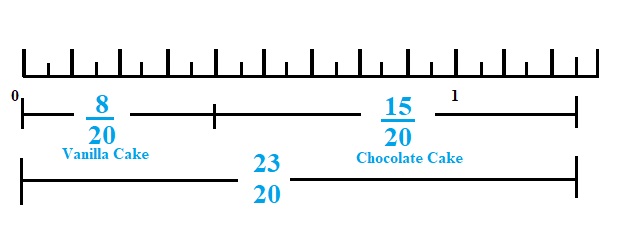
Quantity of flour used for vanilla cake = \(\frac{2}{5}\)
Quantity of flour used for chocolate cake = \(\frac{3}{4}\)
Total Quantity flour used = \(\frac{2}{5}\) + \(\frac{3}{4}\) = \(\frac{8}{20}\) + \(\frac{15}{20}\) = \(\frac{23}{20}\)
Question 3.
Carlos wants to practice piano 2 hours each day. He practices piano for \(\frac{3}{4}\) hour before school and \(\frac{7}{10}\) hour when he gets home. How many hours has Carlos practiced piano? How much longer does he need to practice before going to bed in order to meet his goal?
Answer:
Number of hours piano practiced before school = \(\frac{3}{4}\) of hour
Number of hours left = 1 – \(\frac{3}{4}\) = \(\frac{1}{4}\)
Number of hours piano practiced in home = \(\frac{7}{10}\) of hour
Number of hours left = 1 – \(\frac{7}{10}\) = \(\frac{10}{10}\) – \(\frac{7}{10}\) = \(\frac{3}{10}\)
Total time spent on practicing = \(\frac{3}{4}\) + \(\frac{7}{10}\) = \(\frac{15}{20}\) + \(\frac{14}{20}\) = \(\frac{29}{20}\)
Numbers of hours left for practicing more = \(\frac{1}{4}\) + \(\frac{7}{10}\) = \(\frac{5 + 14}{20}\) = \(\frac{19}{20}= \)
Eureka Math Grade 5 Module 3 Lesson 4 Exit Ticket Answer Key
Question 1.
Draw a model to help solve \(\frac{5}{6}\) + \(\frac{1}{4}\). Write your answer as a mixed number.
Answer:
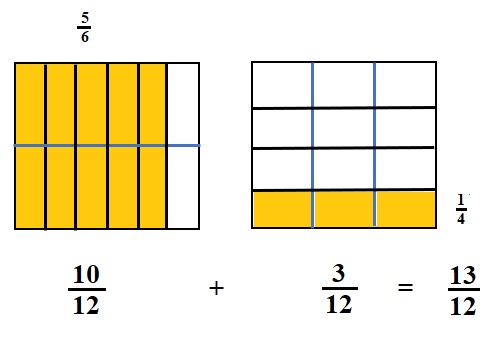
Explanation :
Divide the first rectangle into 6 parts using vertical lines as first fraction is \(\frac{5}{6}\) and each vertical section represents \(\frac{1}{6}\) and 5 parts are shaded.
Divide the Second rectangle into 4 parts using horizontal lines as Second fraction is \(\frac{1}{4}\) and each horizontal fraction represent \(\frac{1}{4}\) and 1 part is shaded.
As 4 and 6 have 12 lcm now divide both the rectangles into 12 parts .
First rectangle divided into 12 parts by drawing 1 horizontal line and second rectangle into 12 parts by drawing 2 vertical line
Write fraction of shaded parts and add them .
Question 2.
Patrick drank \(\frac{3}{4}\) liter of water Monday before jogging. He drank \(\frac{4}{5}\) liter of water after his jog. How much water did Patrick drink altogether? Write your answer as a mixed number.
Answer:
Quantity of Water Drank before jogging = \(\frac{3}{4}\) liter
Quantity of Water Drank after jog = \(\frac{4}{5}\) liter
Total Quantity of water drank = \(\frac{3}{4}\) + \(\frac{4}{5}\) = \(\frac{15}{20}\) + \(\frac{16}{20}\) = \(\frac{31}{20}\) = 1\(\frac{11}{20}\) litre
Therefore, Total Quantity of water drank = 1\(\frac{11}{20}\)
Eureka Math Grade 5 Module 3 Lesson 4 Homework Answer Key
Question 1.
For the following problems, draw a picture using the rectangular fraction model and write the answer. When possible, write your answer as a mixed number.
a. \(\frac{3}{4}\) + \(\frac{1}{3}\) =
b. \(\frac{3}{4}\) + \(\frac{2}{3}\) =
c. \(\frac{1}{3}\) + \(\frac{3}{5}\) =
d. \(\frac{5}{6}\) + \(\frac{1}{2}\) =
e. \(\frac{2}{3}\) + \(\frac{5}{6}\) =
f. \(\frac{4}{3}\) + \(\frac{4}{7}\) =
Answer:
a. \(\frac{3}{4}\) + \(\frac{1}{3}\)
lcm of 3 and 4 is 12 .
= \(\frac{9}{12}\) + \(\frac{4}{12}\) = \(\frac{13}{12}\) .

Explanation :
Divide the first rectangle into 4 parts using vertical lines as first fraction is \(\frac{3}{4}\) and each vertical section represents \(\frac{1}{4}\) and 3 parts are shaded.
Divide the Second rectangle into 3 parts using horizontal lines as Second fraction is \(\frac{1}{3}\) and each horizontal fraction represent \(\frac{1}{3}\) and 1 part is shaded.
As 4 and 3 have 12 lcm now divide both the rectangles into 12 parts .
First rectangle divided into 12 parts by drawing 2 horizontal lines and second rectangle into 12 parts by drawing 3 vertical line
Write fraction of shaded parts and add them .
b. \(\frac{3}{4}\) + \(\frac{2}{3}\)
lcm of 4 and 3 is 12 .
= \(\frac{9}{12}\) + \(\frac{8}{12}\) = \(\frac{17}{12}\) .
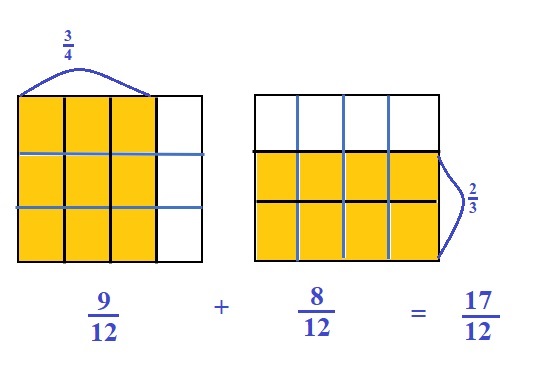
Explanation :
Divide the first rectangle into 4 parts using vertical lines as first fraction is \(\frac{3}{4}\) and each vertical section represents \(\frac{1}{4}\) and 3 parts are shaded.
Divide the Second rectangle into 3 parts using horizontal lines as Second fraction is \(\frac{2}{3}\) and each horizontal fraction represent \(\frac{1}{3}\) and 2 parts are shaded.
As 4 and 3 have 12 lcm now divide both the rectangles into 12 parts .
First rectangle divided into 12 parts by drawing 2 horizontal lines and second rectangle into 12 parts by drawing 3 vertical line
Write fraction of shaded parts and add them .
c. \(\frac{1}{3}\) + \(\frac{3}{5}\)
lcm of 3 and 5 is 15 .
\(\frac{5}{15}\) + \(\frac{9}{15}\) = \(\frac{14}{15}\) .
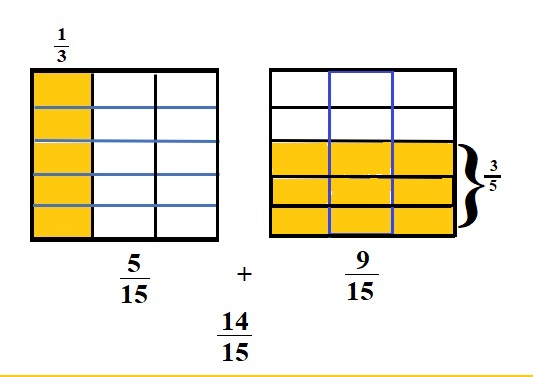
Explanation :
Divide the first rectangle into 3 parts using vertical lines as first fraction is \(\frac{1}{3}\) and each vertical section represents \(\frac{1}{3}\) and 1 part is shaded.
Divide the Second rectangle into 5 parts using horizontal lines as Second fraction is \(\frac{3}{5}\) and each horizontal fraction represent \(\frac{1}{5}\) and 3 parts are shaded.
As 5 and 3 have 15 lcm now divide both the rectangles into 15 parts .
First rectangle divided into 15 parts by drawing 4 horizontal lines and second rectangle into 15 parts by drawing 4 vertical line
Write fraction of shaded parts and add them .
d. \(\frac{5}{6}\) + \(\frac{1}{2}\)
lcm of 2 and 6 is 6 .
= \(\frac{5}{6}\) + \(\frac{3}{6}\) = \(\frac{8}{6}\)
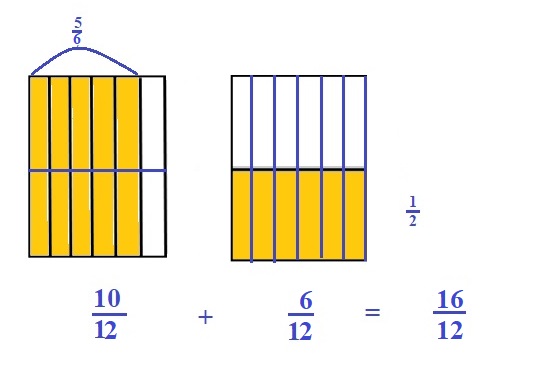
Explanation :
Divide the first rectangle into 6 parts using vertical lines as first fraction is \(\frac{5}{6}\) as each vertical section represents \(\frac{1}{6}\) and 5 parts are shaded.
Divide the Second rectangle into 2 parts using horizontal lines as Second fraction is \(\frac{1}{2}\) as each horizontal fraction represent \(\frac{1}{2}\) and 1 part is shaded.
As 2 and 6 have 6 lcm now divide both the rectangles into 6 parts .
First rectangle divided into 6 parts by drawing 1 horizontal line and second rectangle into 6 parts by drawing 5 vertical line
Write fraction of shaded parts and add them .
e. \(\frac{2}{3}\) + \(\frac{5}{6}\)
lcm of 3 and 6 is 6
\(\frac{4}{6}\) + \(\frac{5}{6}\) = \(\frac{9}{6}\) = \(\frac{3}{2}\) .
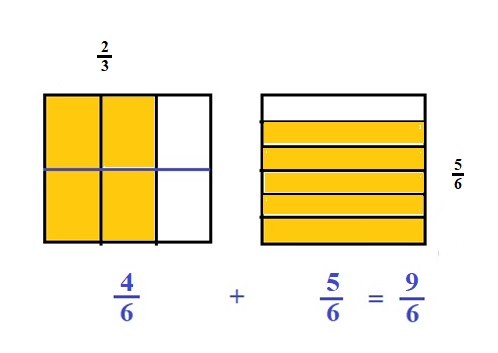
Explanation :
Divide the first rectangle into 6 parts using vertical lines as first fraction is \(\frac{2}{3}\) as each vertical section represents \(\frac{1}{3}\) and 2 parts are shaded.
Divide the Second rectangle into 6 parts using horizontal lines as Second fraction is \(\frac{5}{6}\) as each horizontal fraction represent \(\frac{1}{6}\) and 1 part is shaded.
As 3 and 6 have 6 lcm now divide both the rectangles into 6 parts .
First rectangle divided into 6 parts by drawing 1 horizontal line and second rectangle is in 6 parts .
Write fraction of shaded parts and add them .
f. \(\frac{4}{3}\) + \(\frac{4}{7}\)
lcm of 3 and 7 is 21
\(\frac{28}{21}\) + \(\frac{12}{21}\) = \(\frac{40}{21}\) =1 \(\frac{19}{21}\) .
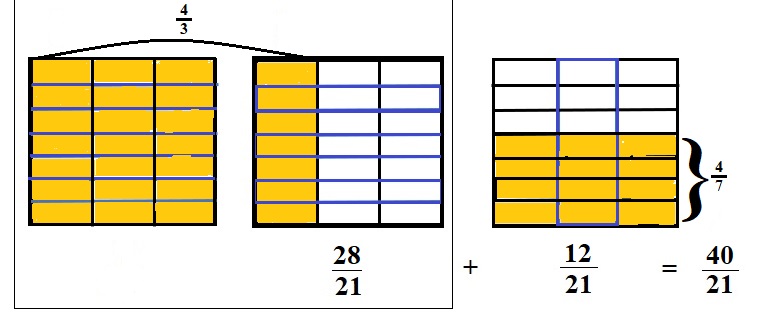
Explanation :
Divide the first fraction contains 2 rectangle into 3 parts each using vertical lines as first fraction is \(\frac{4}{3}\) and each vertical section represents \(\frac{1}{3}\) and 4 parts are shaded
Divide the Second rectangle into 7 parts using horizontal lines as Second fraction is \(\frac{4}{7}\) and each horizontal fraction represent \(\frac{1}{7}\) and 4 parts are shaded.
As 7 and 3 have 21 lcm now divide both the rectangles into 21 parts .
First rectangle divided into 21 parts by drawing 6 horizontal lines and second rectangle into 21 parts by drawing 2 vertical line
Write fraction of shaded parts and add them .
Solve the following problems. Draw a picture, and write the number sentence that proves the answer. Simplify your answer, if possible.
Question 2.
Sam made \(\frac{2}{3}\) liter of punch and \(\frac{3}{4}\) liter of tea to take to a party. How many liters of beverages did Sam bring to the party?
Answer:

Quantity of punch used = \(\frac{2}{3}\) liter
Quantity of Tea used = \(\frac{3}{4}\) liter
Quantity of beverages = \(\frac{2}{3}\) + \(\frac{3}{4}\) liter = \(\frac{8}{12}\) + \(\frac{6}{12}\) = \(\frac{14}{12}\) = 1 \(\frac{2}{12}\).
1 liter and \(\frac{2}{12}\) liter Beverages Sam brought to the party .
Question 3.
Mr. Sinofsky used \(\frac{5}{8}\) of a tank of gas on a trip to visit relatives for the weekend and another 1 half of a tank commuting to work the next week. He then took another weekend trip and used \(\frac{1}{4}\) tank of gas. How many tanks of gas did Mr. Sinofsky use altogether?
Answer:
Quantity of gas used for trip = \(\frac{5}{8}\)
Quantity of gas used for work = \(\frac{1}{2}\)
Quantity of gas used for another trip = \(\frac{1}{4}\)
Total gas used = \(\frac{5}{8}\) + \(\frac{1}{2}\) + \(\frac{1}{4}\) = \(\frac{5}{8}\) + \(\frac{4}{8}\) + \(\frac{2}{8}\) = \(\frac{11}{8}\) = 1\(\frac{3}{8}\)
= 1 \(\frac{3}{8}\) = 1 + \(\frac{3}{8}\) that means 1 tank and \(\frac{3}{8}\) of tank of gas .
